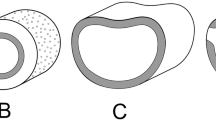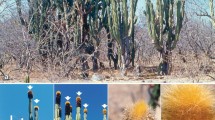Abstract.
Diverse forms of superficial sori are typologically analysed and their potential relations, especially those of submarginal to marginal sori, are discussed. Within the superficial sori, two main types are differentiated: the non-vein-related and the vein-related superficial sorus. The first type is defined as the combination of (a) a small-celled minute, cushion-, or ridge-shaped receptacle, (b) a mixed sequence of sporangial initiation, and (c) the absence of indusial formations. The second type is bound to the underside of a vein and comprises (a) a minute, lop-sided, ring-, cone-, or ridge-shaped receptacle, (b) a simultaneous, mixed, or basipetal sequence of sporangial initiation, and (c) a scale-like, peltate, cup-like, or long-extended indusium. Submarginal and marginal sori arise as the result of phase differentiation in leaf development and additional developmental processes. These take place in different combinations yielding several pathways for the evolution of submarginal and marginal sori: The state of superficial singly-arranged sporangia as seen in Pityrogramma may give rise to the Pteris type of the non-vein-related superficial sorus and the Pteridium type of the basipetal marginal sorus. The Pteridium type may also arise from the Pteris type. The Dicksonia type of the basipetal marginal sorus may evolve from the state of superficial singly-arranged sporangia as seen in Anogramma, from the Cyathea type of the vein-related superficial sorus, or from the Pteridium type. With regard to the phylogenetic relationships the present studies allow the following conclusions: (1) Although there are constructional relations between sori as in Pteridium and in Pteris, it is not advisable to regard Hypolepidaceae as Pteridaceae, since the construction of the rhizomes of the two families are very different. (2) Because a sorus as in Pteridium can be traced back to one like that in Pteris, and the latter to a state as seen in Pityrogramma, a placement of Pteridaceae after Hypolepidaceae is questionable. However, since a sorus as in Pteridium could also be directly derived from a state of superficial singly-arranged sporangia as occurs, e.g. in Pityrogramma, the similarity of the sori of Pteris and Pteridium may also be due to analogous convergence. Therefore, a relationship between these genera, if there is one at all, need not necessarily be close. (3) A basipetal marginal sorus as found in Dicksoniaceae shows constructional relations to a vein-related superficial sorus such as that in Cyatheaceae. But because a relationship between Dicksoniaceae and Dennstaedtiaceae cannot be excluded (Schölch 2000b), it can be questioned whether Dicksoniaceae and Cyatheaceae are related at all.
Similar content being viewed by others
Author information
Authors and Affiliations
Additional information
I would like to express special thanks to Professor Dr. Wolfgang Hagemann for very valuable hours of discussion and for giving me insights into new concepts and ideas of his research. I am also grateful to Mrs. Prunella M. Götz B.A. for checking the English text, and to two anonymous reviewers who provided critical and judicious comments for the scientific and stylistic improvement of the manuscript.
Rights and permissions
About this article
Cite this article
Schölch, A. Relations between submarginal and marginal sori in ferns III. Superficial sori with emphasis on Pteridaceae and morphological relations to marginal sori. Plant Syst. Evol. 240, 211–233 (2003). https://doi.org/10.1007/s00606-003-0023-0
Received:
Published:
Issue Date:
DOI: https://doi.org/10.1007/s00606-003-0023-0




